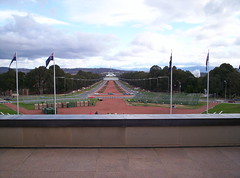April 28
Canberra
Rainy and Cold
Our tour of Canberra is always one of the most interesting days of the course. We visit the Australian Parliament House, the US Embassy, and the ANZAC War Memorial. It's the day that the students learn about the important relationship between the USA and Australia.
We began at Parliament House at 9am. Our tour guide, John, was a former ministerial aide, and certainly an expert on the workings of Australian government. He was also a well-traveled man, and understood US government as well. As a result, he was a perfect guide for our students, pointing out similarities and differences between the two systems.
Australian government is bicameral, like ours, with one house elected more or less proportional to the population, the other with equal representation for the states. Of course, the head of the government is a prime minister; the executive portion of the government is not a separate branch, but contained within the majority party or coalition of the legislature.
The building is remarkable, containing many layers of symbolism to remind the citizens and government officials alike of their roots and their mission. The colors are chosen to reflect the land: the reds of the harsh interior; the greens of the eucalyptus forests. Most of the building is underground with parkland above, so the government building literally supports the citizens above. It is a beautiful building, and reflects the finest in Australia.
This year Parliament House was very quiet. I think we hit the very tail end of the school field trips (down here called 'school holidays'), so probably will not see a lot of children at most of the places we visit, as we sometimes have in past years. I did learn something interesting that explains the high level of knowledge most Australians have of their government: travel for schoolchildren to Parliament House is subsidized: the farther one lives from Canberra, the higher the level of subsidy. The chambers of both houses are equipped with classroom areas into which teachers can bring their classes and have them watch Parliament in action.
Our trip to the U.S. Embassy often is a moment when some of our students get a glimpse of a possible career in the Foreign Service. We meet with four embassy staff, officers from some of the sections. The generalist officers we meet with rotate their post every two years; this policy prevents them from getting to know the country so well that they become its advocate rather than ours. It's a perfect career for someone who wants to travel around a lot and get to see many parts of the world.
The ANZAC War Memorial also houses one of the best military museums one will find. The matching of memorial and the museum was intentional and wise; placing the Roll of Honour and the Tomb of the Unknown in a moving context.
For this visit, I concentrated on the battle of Gallipoli and the Kokoda trail. Since I've already written about Gallipoli, I'll explain what little I know of Kokoda. This trail cuts across Borneo; the Japanese in WWII intended to use this as a route by which they would stage an invasion of Australia. Keeping this from happening was a key objective of the Battle of the Coral Sea. Defending this trail was a band of Australia militia that faced incredible odds. They were successful in keeping the Japanese from completing the trail, but suffered heavy losses. Along with Gallipoli, Kokoda is remembered as another in a long line of battles that showcased to the world the character of the Australian solider.
AT the ANZAC War Memorial shop, I found a very cute little book that I had to have: a reproduction of the US War Department's 1942 booklet "Instructions for American Servicemen in Australia." It contains a lot of interesting facts, along with a fair amount of misinformation. But I will think of my Uncle Burt Jacobson, who was stationed in Australia at the time, every time I look at the book.
It is now early on the 29th, and we will fly out to Brisbane soon. It's sunny and in the 70s there, so we'll shake the chill off.
Monday, April 28, 2008
Subscribe to:
Post Comments (Atom)

No comments:
Post a Comment